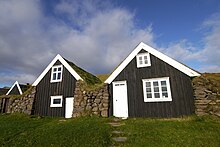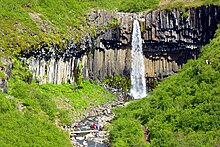Skaftafell National Park
| Skaftafell National Park | ||
|---|---|---|
|
|
||
| Location: | Austurland , Iceland | |
| Surface: | 4,800 km² | |
| Founding: | September 15, 1967, existed until 2008 | |
| Address: | see Vatnajökull National Park | |
The Skaftafell National Park ([ ˈskaftafɛtl̥ ]) was a protected area in Öræfi , in southeast Iceland . It was founded on September 15, 1967 and has since expanded three times. On September 12, 2004, the national park was enlarged again and was one of the largest in Europe with over 4,800 km² by 2008 . On June 7th, 2008 the Skaftafell National Park was incorporated into the Vatnajökull National Park .
Surname
The national park is named after the mountain Skaftafell, an extinct and eroded volcano , the remains of which represent the Kristínartindar .
Settlement history

Shortly after the colonization of Iceland, a large homestead was established in Skaftafell and the area was designated as a meeting place (Þing) . However, the catastrophic eruption of the Öræfajökull volcano in 1362 wiped out the entire local population and the area has since been referred to as “ Öræfi ” - no man's land. Skaftafell and many other farms were soon rebuilt, but the cooling of the climate made life from agriculture increasingly difficult. The regular eruptions of the Grímsvötn volcano caused jökulhaup ( Isl. For glacier runs ), which flooded grassy areas and left a layer of ash and sand. In 1988 traditional farming in Skaftafell was finally stopped.
In the past, when the climate was more favorable, farmers increased their income from sheep breeding by going to the coast to hunt seals and collect eggs . Shipwrecks provided excellent material for various structures and some of the Skaftafell farmers became famous for their woodwork.
In earlier centuries the Skaftafell farmstead stood at the foot of the mountains, in Gömlutún you can still see some ruins today . When the Skeiðará river began to shift its course towards the homestead and flooded the adjacent fields, the houses were moved up the slope at the beginning of the 19th century and divided into three buildings. One of them, Sel , was abandoned in 1946. Sel was restored by the National Museum and is now open to visitors.
Landscape and geology
The area around Skaftafell is characterized by strong contrasts. Various glacier tongues are surrounded by jagged mountain ridges, of which the glaciated Hvannadalshnjúkur stands out the highest. The evidence of the erosive forces from glaciers and rivers is manifold. Since the time of the first sagas in Iceland, the ice has moved back and forth several times, with a maximum around 1890. Since then, the glacier has been retreating. The glacial rivers often changed their riverbed across the plateau, leaving behind the sediments that form the sands of Skeiðarársandur today . The ring road no. 1 was completed as a complete ring around Iceland, as in 1974 the last river, the Skeiðará , was bypassed. In 2009, however, the Skeiðará changed its course: instead of flowing under the bridge, it now flows into the Gígjukvísl river to the west, directly in front of the glacier . Therefore, the river under the long Skeiðará bridge in the east has relatively little water.
The area around Skaftafell has experienced volcanic times of varying severity. In 1362, the volcanic eruption of Öræfajökull released the largest amount of ash of all Icelandic volcanoes since settlement began. A smaller eruption occurred in 1727. As was shown again in 2011, the subglacial volcano Grímsvötn is one of the most active volcanoes on the island. It is also known for its jökulhlaups or glacier runs.
Plants and wildlife
Compared to other places on the south coast of Iceland, Skaftafell has a mild and pleasant climate. The area often benefits from the protection of the slopes of Öræfajökull . Birch trees and the occasional ash tree cover the fertile lower mountain slopes and the birch trees in Bæjarstaðarskógur grow taller than most other native birches. Various flowering plants that are characteristic of East Iceland bloom here: the round-leaved bellflowers , buckhorn and saxifrage .
The composition of the vegetation has undergone major changes since the sheep farm in Skaftafell ceased and plants continue to thrive inland at the foot of Skaftafellsjökull and in the Morsárdalur valley . Species such as the real angelica, the forest angelica, the beach pea or the arctic willowherb are rarely found on pastures, but are now often to be found here. Birches and willows are also starting to grow again on this stretch of land.
Down on the mountain slopes of the forests you can often find red thrushes , siskins and wrens . Snipe , ptarmigan , golden plover and meadow pipit , on the other hand, tend to stay further up the slope. Other bird species such as ravens , pygmy falcons , wheatear and snow bunting are also native to the park. The only wild mammals are the arctic fox , field mice and feral mink . The local insect world can be seen as quite diverse, at least compared to the rest of Iceland.
Svartifoss waterfall
A famous waterfall lies in this national park: the Svartifoss . You can find it on many calendar pictures because it foams white against a background of black basalt columns.
In addition to Svartifoss, this national park has recently added Iceland's highest waterfall. A waterfall of 227 meters has been created in Morsárjökull. He was named Morsárfoss .
The National Park
When the Vatnajökull National Park was founded in the summer of 2008, the former Skaftafell National Park was incorporated. Skaftafell itself has been protected since 1967. Declared goals include making it accessible to the public as well as preserving its flora , fauna , landscape and cultural heritage .
Open all year round, the Skaftafell Visitor Center looks after the southern area of Vatnajökull National Park and offers park visitors information about the park, its surroundings, existing hiking trails , its nature and history as well as other leisure activities and offers. Exhibition boards in the visitor center describe the intertwined history between people and nature in Skaftafell. Skaftafell is home to a variety of hiking trails and the spacious campground offers space for tents , tent trailers or caravans . The campsite itself is only open between May 1st and September 30th. At other times of the year, camping can be carried out in consultation with the park staff.
In summer, the park rangers offer guided hikes and other events such as lessons or activities for children.
Settlement
There were originally a few larger farms in the area. However, most were abandoned over time after the upstream farmland because of the outbreaks of Öræfajökull and the glacier runs of Skeiðará in black Sander had transformed.
The two remaining courtyards are mainly dedicated to tourism . The Sel museum courtyard is located between the two courtyards . There is also a campsite and a tourist information center at the entrance to the national park. The park is well developed with hiking trails.
Þórður Tómasson , the director of the Skógar Museum, described life in this area in earlier times in his Icelandic book Skaftafell - Þættir úr sögu ættarseturs og atvinnuþátta in 1980 .
Transport links
The national road 1, the Hringvegur , leads almost directly past the national park center.
Skaftafell National Park is 327 kilometers by road from Reykjavík . After Höfn there are 136 km.
See also
literature
- Hjörleifur Guttormsson, Oddur Sigurðson: Leyndardómur Vatnajökuls. Viðerni, fjöll and byggðir. Stórbrotin náttúra, eldgos og jökulhlaup. Reykjavík (Fjöll og firnindi) 1997 ISBN 9979-60-325-9
- Þórður Tómasson: Skaftafell - Þættir úr sögu ættarseturs og atvinnuþátta. 1980
Web links
- Official website (English)
- German brochure (pdf; 420 kB)
- Claus-Peter Lieckfeld : " Ice cream with hot - the Vatnajökull National Park has been opened in Iceland, the largest in all of Europe " In: DIE ZEIT No. 40 of September 25, 2008
Individual evidence





